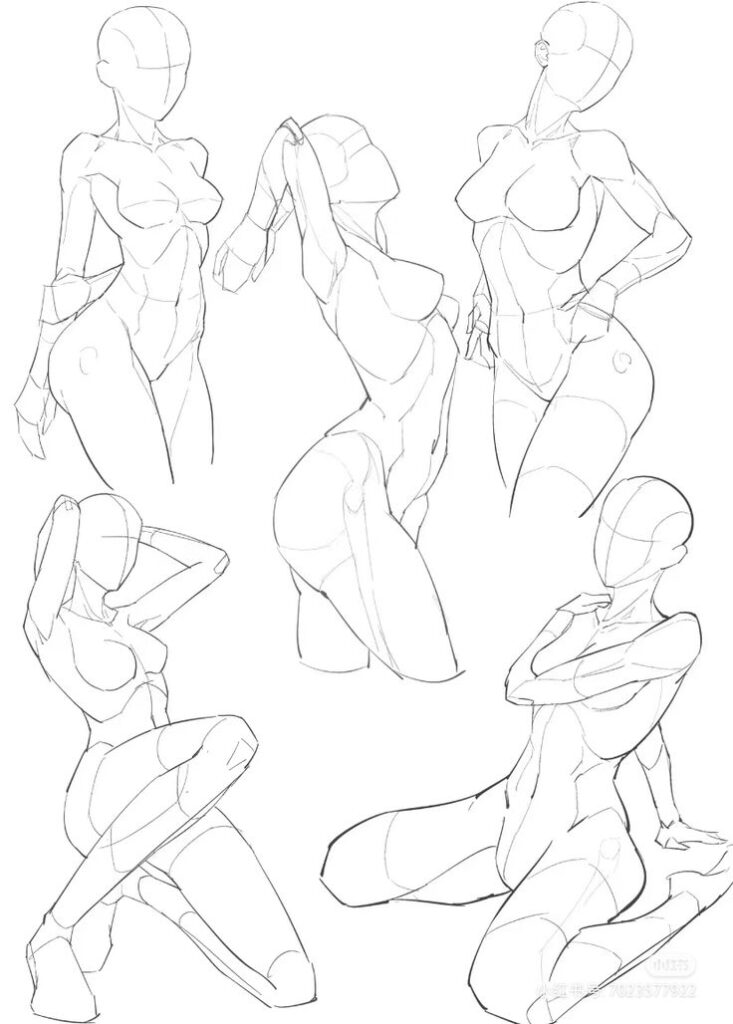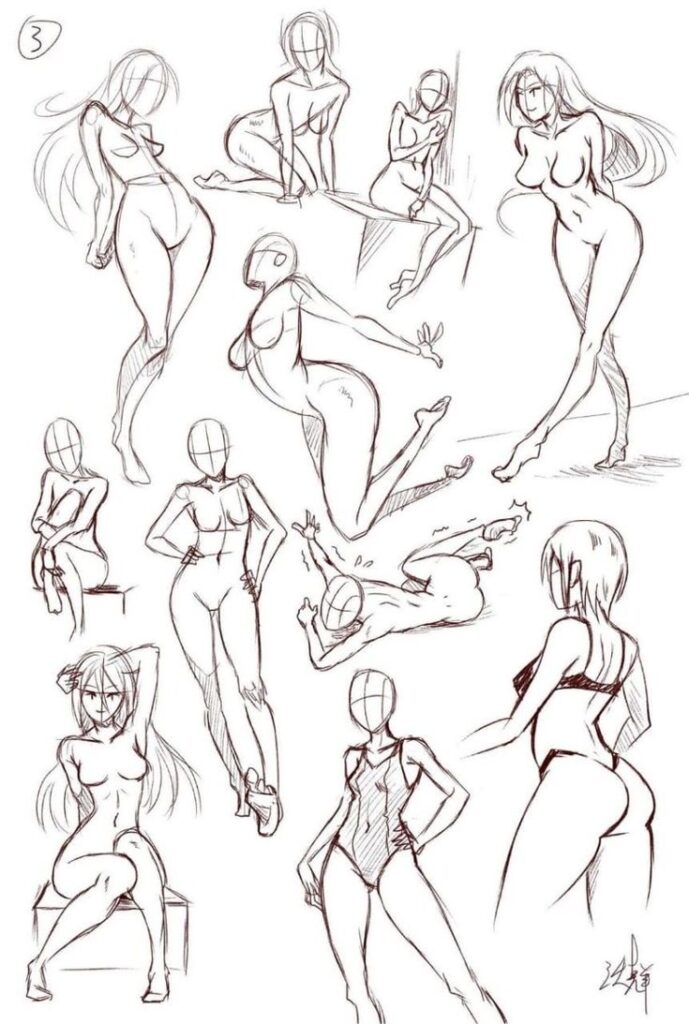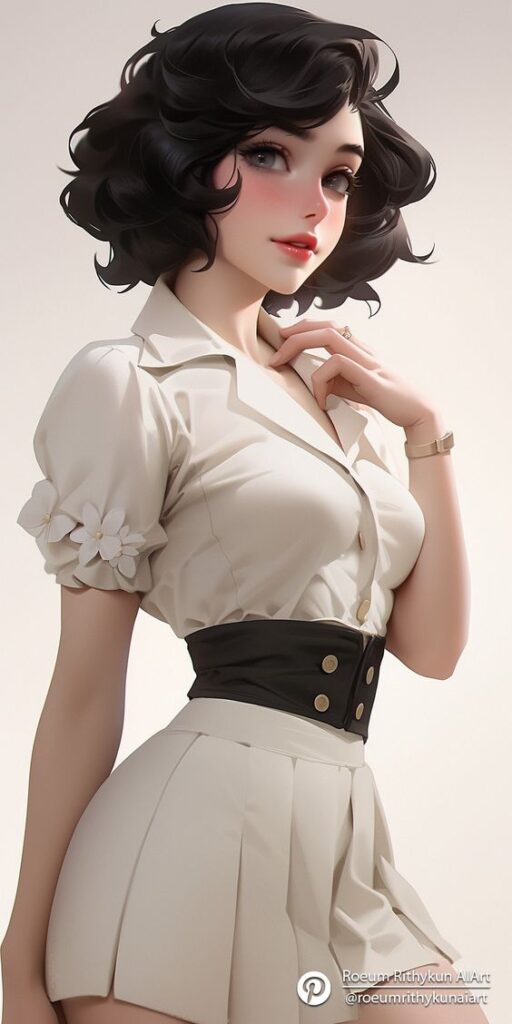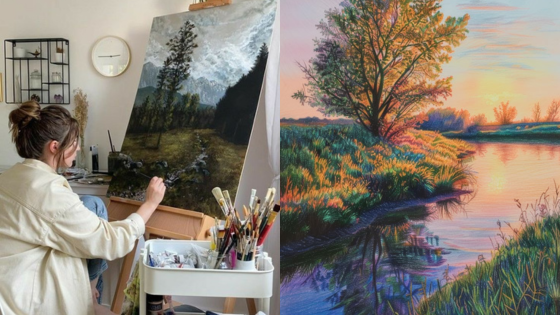Embarking on the journey to draw human forms can initially seem daunting, but it doesn’t have to be. To excel in drawing bodies, artists must grasp not only the basic shapes but also the intricacies of human anatomy. By focusing on proportions and gesture drawing, individuals can start creating more lifelike figures.


For any aspiring artist, the setup is crucial. Utilizing reference photos and understanding proportion are key steps in achieving more realistic results. Developing these skills allows artists to capture movement and emotion in their drawings effectively.
Recognizing that each body part requires a unique approach is critical. Artists can bring their figures to life by honing specific drawing techniques and exploring different styles. By practicing consistently and integrating practical tips, anyone can improve their art.
Key Takeaways
- Grasping basic shapes and anatomy is essential for drawing bodies.
- Proportions and gestures are crucial for lifelike art.
- Practice and varied techniques enhance drawing skills.
Understanding Human Anatomy


Accurate figure drawing requires knowledge of human anatomy, focusing on body proportions and structural details. The skeleton sets the foundational dimensions, muscles add volume and definition, and gender differences influence overall form. Mastering these elements aids in creating anatomically correct figures.
The Skeleton: Foundation of Proportions
The skeletal structure serves as the basis for understanding human proportions. The spine supports the vertical structure and connects to the pelvis, influencing posture and balance. The eight-head rule helps artists measure body height, dividing the body into equal parts for consistency. The knees and elbows act as vital hinges in limb movement.
Basic Body Proportions:
- Head: 1 head unit
- Torso to Pelvis: 3 head units
- Legs: 4 head units
The forearm and upper arm are distinct segments contributing to arm length. Understanding these elements ensures correct depiction of motion and stance. Precision in these areas helps create realistic and balanced figures.
Muscle Structure and Definition
Muscle anatomy contributes to the body’s contour and structure. By learning how muscles overlap and function, artists can accurately capture muscle definition. Key muscle groups like biceps and triceps in the arms and quadriceps in the legs must be articulated properly. This awareness anchors the dynamics of gesture drawings.
Muscles over the pelvis and spine add bulk and form, smoothing transitions between skeletal landmarks. They impact shading and texturing, offering realism to the drawn figure. Observing how muscles expand and contract in different poses enhances depth and lifelike quality in artwork.
Male vs Female Anatomy


Recognizing differences between male and female anatomies is crucial. Male anatomy typically features broader shoulders and a narrower pelvis, contributing to a more V-shaped torso. Male body proportions often emphasize muscularity and angular lines, reflecting strength.
Female anatomy, in contrast, exhibits wider hips and a narrower waist, creating an hourglass silhouette. Female body proportions emphasize softer curves and slender lines. These anatomical variations inform body posture, attire, and movement, adding diversity to character designs.
A thorough analysis of these distinctions assists in creating anatomically accurate and expressive figures. Understanding these elements allows artists to portray gender-specific characteristics effectively in their work.
Setting Up Your Drawing
Establishing the right environment and having the appropriate materials is vital in creating accurate and well-composed drawings. Artists should consider factors like workspace organization and material selection to enhance their drawing techniques.
Choose the Right Materials
Selecting the right materials is crucial in adapting to different styles of drawing. Paper quality affects texture and shading, with options ranging from smooth surfaces for fine details to rough ones for a more expressive effect. Pencils come in various grades of hardness, from H (hard) to B (soft), enabling artists to achieve varying line qualities.


Avoid cheap materials that may compromise the artwork’s quality, and instead, invest in reputable brands. Quality erasers and sharpeners are essential tools for refining and correcting details. Observing the differences between various tools can greatly improve skills and techniques in drawing.
Preparing Your Workspace
Organizing the workspace sets the foundation for an efficient drawing process. A well-lit environment is important; natural light is ideal, but adjustable lamps work well too. Ensure the drawing area is free from clutter to maintain focus and precision.
A sturdy desk provides stability, and an ergonomic chair minimizes fatigue during long drawing sessions. Keep frequently used materials within reach to streamline the creative process. Observing object placements and keeping a tidy space encourages consistent practice, allowing artists to concentrate on honing their craft.
The Art of Gesture Drawing


Gesture drawing focuses on capturing the essence of the human figure with fluid lines and shapes. It highlights movement and energy rather than detailed anatomy, allowing artists to express body language and dynamism. Precision isn’t the goal; rather, it’s about conveying emotions and actions through quick sketches.
Capturing the Body’s Movement
Gesture drawing is fundamental in understanding how to effectively capture movement. Artists start with loose, sweeping strokes that represent the flow and direction of the body. This approach helps in recognizing the natural dynamics and weight distribution of the human figure.


Attention to basic shapes, such as circles and ovals, can help in quickly outlining the posture and movement. Observing how joints like shoulders, hips, and knees shift during various activities is crucial. An artist gains insight by continuously practicing fast sketches, ideally timed at 30 seconds to two minutes, which helps in reinforcing speed and precision in capturing fluidity.
Expressing Body Language Through Gestures
Gesture drawing is also an effective technique for conveying body language. By focusing on the overall posture and alignment of limbs, artists can express emotional states or intentions of the figure. The posture might reveal emotions like confidence, relaxation, or tension.
Incorporating exaggerated poses can further highlight specific emotions or actions. Observing live models or videos can provide valuable insights into subtle gestures that communicate mood. Artists often use light and dark strokes to emphasize stress points or relaxed areas.
Experimentation with different drawing tools, such as charcoal or pencil, can achieve varying line weights and fluidity, adding to the expressiveness. Through careful observation and practice, gesture drawing becomes a useful skill in conveying powerful, emotive scenes.
Drawing the Body in Proportion


Achieving accurate proportions is essential for drawing realistic human figures. Artists often use methods like the eight-head rule to maintain consistency and adjust proportions for different body types to add variation.
Applying the Eight-Head Rule
The eight-head rule is a common technique used by artists to maintain consistent body proportions. This method involves dividing the entire figure into eight equal parts, each equivalent to the height of the head.
Advantages:
- Simplifies the process of scaling different body segments.
- Ensures a balanced appearance.
The head acts as a fundamental unit of measurement. The torso usually takes up about two to three head lengths, with the waist to knee covering another two. The legs typically measure about three head lengths. Utilizing this approach helps in creating a well-proportioned figure that aligns with classical depictions of the human form.
Adjusting Proportions for Different Body Types


Different body types require adjustments to the standard proportions. While the eight-head model serves well for idealized figures, variations occur based on age, gender, and body composition.
Considerations:
- Shorter or taller figures.
- Variations in muscle mass and fat distribution.
For instance, children often have larger heads in proportion to their bodies, making them generally around five to six heads tall. For more muscular builds, you might broaden the chest and shoulders. Recognizing these differences allows the artist to represent diverse body types realistically, reflecting the vast spectrum of human shapes.
Developing the Form


Developing the form involves transitioning from basic stick figures to detailed body shapes, focusing on structure and volume. Mastering these concepts will enhance one’s ability to create realistic human forms with accurate proportions and depth.
From Stick Figures to Full Forms
Starting with stick figures simplifies the initial steps of structure drawing. These are basic representations of the body, providing a framework for understanding proportions and movement. By using lines for limbs and curves for joints, artists can map out the basic posture and motion.
Progressing to full forms requires integrating basic shapes like cylinders, spheres, and blocks around the stick framework. This helps in fleshing out the outline of the body, creating a more substantial representation. Paying attention to the alignment and length of these shapes ensures that proportions remain accurate.
It’s crucial to practice consistently, gradually adding complexity to these forms. Observing real-life models or reference images can also enhance one’s understanding of anatomy and muscle placement.
Adding Volume to the Body Outline
Adding volume transforms a simple body outline into a three-dimensional form. This starts by identifying key muscle groups and fleshing them out using rounded shapes. For instance, ovals can depict muscles, while broader rectangles can represent the torso’s volume.
Shading techniques are invaluable in this process, helping to convey depth and weight. Artists should focus on light sources when drawing shadows, highlighting the contours and curves of the body. This creates the illusion of solidity and form.
Practicing with different body types and positions can improve one’s skills in adding volume. Tools such as digital software can also be used to easily manipulate and experiment with these techniques.
Mastering Specific Body Parts


Understanding the nuances of the human form involves focusing on critical areas like the torso, limbs, and head, emphasizing elements such as muscles and joints. Precision in drawing each part ensures anatomically correct and realistic representations.
Drawing the Torso
The torso forms the core of the human body, consisting of the rib cage, spine, and pelvis. Successful depiction involves recognizing the interplay between these elements and the surrounding muscles. Visualize the torso as a three-dimensional structure, keeping in mind that its shape and movement alter with posture.
Study the abdomen and chest, noticing how muscles like the pectorals and abdominals create contours. It’s helpful to employ basic shapes—such as rectangles and ovals—to map out the structure initially.
Depicting Limbs and Extremities
Limbs require attention to anatomy and muscle dynamics. Start with simple skeletal forms to establish proportions, focusing on the joints like the elbows and knees which dictate movement. The arms and legs should reflect underlying muscles, such as the triceps and quadriceps, adding volume and definition to the shape.
Consider the smaller extremities, including the hands and feet, breaking them down into shapes for more accurate placement and joint articulation. Pay attention to the way fingers and toes align, bending realistically.
Portraying the Head and Facial Features
The head houses crucial elements—eyes, nose, mouth—that define expression and identity. Begin by sketching an oval, dividing it vertically and horizontally to establish symmetry and placement for facial features.
Proportions are key: eyes are typically one eye-width apart, while the nose is central to the face. Muscles of the face impact expression; observe how they stretch and contract with emotions. The neck deserves equal consideration as it supports the head and connects it gracefully to the torso.
Bringing Life to Your Figures


To bring life to figures, artists can focus on incorporating detailed elements and conveying a sense of personality and feeling. This involves understanding aspects like muscle definition and body language.
Adding Details for Realism
Adding detail is crucial for making drawings feel lifelike. Muscle definition plays a key role, particularly when capturing action or movement. Observing how muscles contract and expand enables precise depiction.
Attention to facial features is equally important. Accurate portrayal of the eyes, nose, and mouth can transform a simple sketch into a lifelike portrait. Take time to study how shadows fall across a face; this creates depth, enhancing realism.
Body language should not be overlooked. Capturing the subtleties in posture and gestures provides valuable context. Even slight adjustments can reveal emotions and intentions.
Creating Character and Emotion
Creating character means instilling unique traits in each figure. Artists should focus on body language and expression. Small elements like tilt of the head or position of the hands can convey distinct personalities.
Emotion can be emphasized through expressive facial features. For instance, a slight change in eyebrow shape can completely alter the perceived mood of the figure. Portrait artists often excel at capturing these nuances.
It’s beneficial to study poses that align with specific feelings. This approach helps in choosing compositions that enhance storytelling. Properties like clothing and hairstyle further distinguish one character from another, adding depth and identity.
Utilizing Reference Photos


Reference photos play a crucial role in enhancing drawing skills, particularly when it comes to anatomical accuracy and observation skills. Artists can greatly benefit from the strategic use of photos, integrating them into regular practice routines.
The Importance of Observation
Observation is a fundamental skill for artists striving to draw realistic bodies. Reference photos provide an excellent platform for honing this skill. By studying detailed images, artists learn to notice subtle features of human anatomy—how muscles curve, the nuances of posture, and the interplay of light and shadow on the body.
Artists should take time to analyze photos before beginning to draw. This process involves focusing on the proportions and relationships between different body parts. Paying attention to these aspects helps create a more accurate representation on paper. Developing this keen eye will ultimately enhance their ability to capture the essence of form more intuitively in both drawing from life and imagination.
Incorporating Photos into Practice
Using reference photos effectively involves integrating them into a structured drawing practice. Aspiring artists should select varied images, ensuring exposure to different body types, angles, and poses. This diversity helps in understanding the complexity and variability of human anatomy.
One effective approach is to start with quick sketches, focusing on capturing the essence of the pose. Artists might use techniques like gesture drawing to emphasize movement and flow. Studying anatomy alongside this practice can deepen an artist’s understanding of the underlying structure of the body.
Finally, refining these sketches with attention to detail and anatomy will improve overall technique. By systematically incorporating reference photos into practice, artists can significantly enhance their drawing proficiency and confidence.
Exploring Drawing Styles
Different styles of drawing influence how artists portray the human body. Realism focuses on lifelike accuracy, while stylization offers more creative representation. Understanding these styles is key for artists aiming to develop their unique approach.
Realism vs. Stylization


Realism in drawing aims to replicate life with precision and accuracy. It involves studying anatomy in detail, focusing on proportions, skin texture, and muscle definition. Artists achieve realism by mastering light and shadow, requiring practice and observation.
Stylization allows artists to infuse personal flair into their work. It simplifies or exaggerates certain elements, diverging from realistic constraints. Styles such as cartoon or abstract illustration emphasize unique, signature modifications. Both realism and stylization present distinct challenges and benefits, catering to different artistic intents and audiences.
Character Illustrations
Character illustrations blend elements of realism and stylization. Artists focus on distinctive features like exaggerated expressions and simplified anatomy. In this style, personality and emotion drive the portrayal, allowing characters to resonate with viewers.
For creating character illustrations, identifying key traits and consistent design elements is vital. Whether designing for a comic book or animated series, clarity and appeal are crucial components. Artists may utilize reference materials or character sketches to refine unique, imaginative styles that effectively depict their envisioned character narratives.
Practical Tips for Improvement


To enhance skills in drawing bodies, regular practice and thoughtful analysis of mistakes are essential. These strategies allow artists to refine drawing techniques and improve observational skills.
Consistent Practice Routines
Developing a consistent practice routine is crucial. Formulating a schedule that dedicates regular time each day or week keeps the artist engaged and allows for steady improvement. Setting specific goals, such as focusing on different body parts or techniques, can provide direction.
Utilizing varied materials and methods helps build versatility. Sketchbooks, digital tablets, or charcoal are good options to explore. These tools enable experimentation with perspective, proportion, and anatomy. Practicing these consistently aids retention and skill development.
Analysing and Learning from Mistakes
Mistakes are integral to skill enhancement. Identifying and studying errors can illuminate weaknesses in technique or observation. It’s helpful to keep a drawing journal to document mistakes and note ways to correct them. This practice encourages active learning and improvement.
Engaging with peer feedback provides alternative perspectives and insights. Constructive critique can highlight overlooked areas, allowing artists to make informed adjustments. Reviewing successful artworks and drawing techniques of others enriches one’s own practice, offering new strategies and inspiration.
- 13.2Kshares
- Facebook0
- Pinterest13.2K
- Twitter7
- Reddit0



